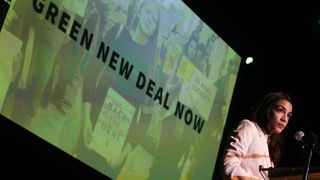Democratic Representative Alexandria Ocasio-Cortez’s Green New Deal resolution has quickly pushed its way to the front of the climate action debate in the United States. Many question how such a radical and sweeping reform plan could be implemented, leading to a common refrain that it is "impossible".
It certainly seems an unlikely prospect under the current US administration, but the Green New Deal is staying in the national political discourse with many states and municipalities already bringing the framework into reality regardless.
What is the Green New Deal?
The Green New Deal harks back to President Franklin D. Roosevelt’s ‘New Deal’, a series of social and economic programs designed to pull the United States out of the Great Depression by actively stimulating the economy. The Green New Deal is a congressional resolution promoting massive federal spending to update US transportation, energy and manufacturing infrastructure to be more cost-efficient. Advocates say it will help put Americans to work while revamping US infrastructure and significantly reducing US contribution to climate change.
The states of the union: US federalism and the Trump policy agenda

If Ocasio-Cortez, her co-sponsors and her supporters are successful in passing the Green New Deal resolution – and the legislation it calls for through both Congress and the White House – the policies have the potential to implement a shift in the US economy that would have a global impact on every nation that does business with the United States.
The uphill battle
With the current administration and opposition from moderate Democrats and Republicans, Ocasio-Cortez and her supporters are facing a long and uphill battle to enact the Green New Deal. Many critics have declared that it is more a list of aspirational goals than feasible objectives. Indeed, Ocasio-Cortez herself describes the Green New Deal as “a statement… a vision document”.
Around 61 per cent of Americans are concerned about the effects of global warming as an issue facing the United States and the world. Some Republicans have also begun to change their stance on climate change. Representative Matt Gaetz is one example. In March, Gaetz drafted what he calls the Green Real Deal: a conservative resolution to addressing climate change that is not as far-reaching as Ocasio-Cortez’s, but acknowledges climate change as a threat to national security.
States go it alone
US cities and states are adopting elements of the Green New Deal’s framework to address local needs. These local adaptations of the Green New Deal are becoming building blocks in accomplishing its establishment nationwide.
For example, Maine’s version of the Green New Deal is the first to be backed by multiple major labour unions – an important ally in infrastructure reform. Meanwhile, the national Green New Deal has only recently gained the support of one labour union. The Illinois Green New Deal focuses on the environmental justice bill while at the national level there has been criticism for including it. Legislators in Washington encompassed utilities in the passage of its Green New Deal, which often are ignored in the climate change discussion regarding the transition of renewables.

Grassroots activism has allowed these states to bring this legislation forward. None more apparent than in Minnesota. It’s Green New Deal, which has been youth-led, pulls from many aspects of the federal Green New Deal, but most significantly aims to transition Minnesota’s utilities to be 100 per cent carbon-free by 2030. Washington is the only state to pass its bill while the others are still in the process. It should be noted that Maine, Illinois and Washington’s legislative branches are Democrat-controlled, but Minnesota’s senate is Republican-controlled and its House of Representatives is Democrat-controlled.
Some states have been building towards something akin to a Green New Deal long before the debate came to Capitol Hill. For example, California has been leading the nation on what sustainable, environmentally-minded reform looks like, and how possible it is to strive for, even without national direction. Although California’s climate and renewable energy policies are not labelled as a ‘Green New Deal’, they seek to accomplish many of the same core aims.
Sowing the seeds of a Green New Deal
The Trump administration will likely never implement something akin to a Green New Deal. That doesn’t mean its death, however. The US federal system allows states to move in a different direction to the White House and this is a case where there is strong evidence that they could.
As momentum builds and states continue to adopt and strengthen legislation with the Green New Deal in mind, the foundation for a national framework will be built incrementally. The Green New Deal is feasible and possible. Municipalities and states around the United States are already making it happen.






